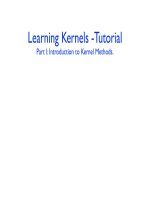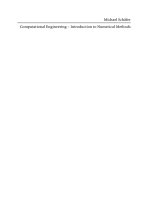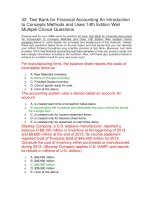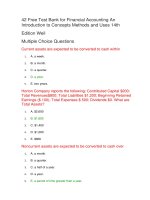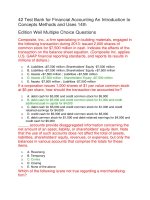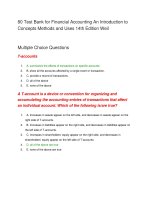Managerial accounting and introduction to concepts methods and user 11e by maher chapter 06
Bạn đang xem bản rút gọn của tài liệu. Xem và tải ngay bản đầy đủ của tài liệu tại đây (314.92 KB, 29 trang )
CHAPTER 6
Financial Modeling
for Short-Term
Decision-Making
PowerPoint Presentation by
LuAnn Bean
Professor of Accounting
Florida Institute of Technology
© 2012 Cengage Learning. All Rights Reserved. May
not be copied, scanned, or duplicated, in whole or in
part, except for use as permitted in a license
distributed with a certain product or service or
otherwise on a password-protected website for
classroom use.
Managerial Accounting 11E
Maher/Stickney/Weil
1
☼
CHAPTER GOAL
☼
This chapter explains and illustrates financial modeling. Financial
modeling can
Provide an overview of an organization’s financial
activities
Help managers make specific decisions
Financial modeling relies on concepts of fixed and variable cost
behavior.
2
LO 1
FINANCIAL MODEL
Financial
Financial modeling
modeling enables
enables analysts
analysts to
to test
test the
the interaction
interaction
of
of economic
economic variables
variables in
in aa variety
variety of
of settings.
settings. ItIt
requires
requires analysts
analysts to
to develop
develop aa set
set of
of equations
equations that
that
represents
represents aa company’s
company’s operating
operating and
and financial
financial
relations.
relations.
3
LO 2
COST-VOLUME-PROFIT (CVP)
CVP can be used to answer questions such as
What effect on profit can GM expect if it builds a
larger SUV?
How will NBC’s profit change if ratings increase
for its evening news program?
How many subscribers must a Dish Network
obtain to break even for the year?
What happens if Verizon reduces fees charged to
customers?
4
E
H
D
LO 2
EXAMPLE: Early Horizons Daycare
Early Horizons Daycare is a daycare center that defines a
unit of output as “service provided for 1 child for a
month.” Building capacity is 30 children. An accountant
developed the following estimates:
Price per child per month
$ 600
Variable cost per child per month
200
5,000
Fixed costs per month
Continued
5
E
H
D
LO 2
CAPACITY and COSTS
Early Horizons Daycare has a capacity of 20
units (relevant range), after which it must hire
more staff.
Variable costs include
Snacks and food
Supplies
A portion of insurance
Fixed costs include:
Rent and utilities
A portion of insurance
Minimum staffing
6
LO 2
BREAK-EVEN
BREAK-EVEN POINT:
POINT: Definition
Definition
Is the point in the basic CVP
model where revenues equal
costs.
Total Revenue = Total Costs
7
E
H
D
LO 2
BREAK-EVEN: Table Format
Using break-even computations:
Sales Revenue (12.5 X $600)
$ 7,500
Less Variable costs (12.5 X $200)
Contribution Margin (CM)
Less Fixed costs
Operating profit
2,500
$ 5,000
5,000
$
0
8
LO 2
CONTRIBUTION
CONTRIBUTION MARGIN:
MARGIN:
Definition
Definition
Is the excess of revenue over
variable costs.
Total Revenue – Variable Costs
9
E
H
D
LO 2
MANAGERS WANT TO KNOW!
Can we use
contribution margin
to compute breakeven (BE) volume?
YES!
BE Volume =
Fixed cost / CM per child
10
E
H
D
CONTRIBUTION MARGIN
APPROACH
LO 2
Using the contribution margin approach:
Break-even Volume = Fixed Costs / CM per child
= $5,000 / $400
= 12.5 children
Click the button to skip
equation approach
11
E
H
D
LO 2
EQUATION APPROACH
Using the equation approach (Operating profit at break-even = 0):
Operating profit 0
= Sales revenue - Costs
= Sales revenue -Variable costs (VC) – Fixed costs (FC)
= (Unit selling price (SP) × Sales volume)
- (VC per unit × Sales volume) - FC
($600 - $200) × Sales volume = $5,000
Sales volumeBE = $5,000/$400 = 12.5 children/month
12
LO 2
MANAGERS WANT TO KNOW!
Can we graph the
relationships in CVP
analysis?
YES!
13
LO 2
E
H
D
By
By
graphing
graphing
revenues
revenues
and
andcosts
costson
on
same
samegraph,
graph,
you
youcan
can
find
findBE,
BE,
profit
profitand
and
loss
lossareas.
areas.
Break-even Volume = Fixed Costs / CM
EXHIBIT 6.1
14
LO 2
E
H
D
Slope
Slopeof
of
line
lineisis
variable
variable
cost
costper
per
unit.
unit.
Break-even Volume = Fixed Costs / CM
EXHIBIT 6.2
15
E
H
D
LO 2
TARGET PROFIT: CM Approach
Sales revenue (20*$600)
$ 12,000
Less Variable costs (20*$200)
4,000
Contribution Margin
$ 8,000
Less Fixed costs
5,000
Operating profit
$ 3,000
Target profit Volume = (Fixed costs + Target Profit) / CM
= ($5,000 + $3,000) / $400
# children = 20
Continued
16
E
H
D
LO 2
TARGET PROFIT: Equation Approach
Sales revenue (20 X $600)
$ 12,000
Less Variable costs (20 X $200)
Contribution Margin
4,000
$ 8,000
Less Fixed costs
5,000
Operating profit
$ 3,000
Sales revenue – Variable costs - Fixed costs = Operating Profit
($600 - $200) × Sales volume - $5,000 = $3,000
$400*Sales volume = $8,000
Sales volume = 20 children
Continued
17
E
H
D
LO 3
TARGET PROFIT: Reminder
Sales revenue (20 X $600)
$ 12,000
Less Variable costs (20 X $200)
Contribution Margin
4,000
$ 8,000
Less Fixed costs
5,000
Operating profit
$ 3,000
Target profit Volume = (Fixed costs + Target Profit) / CM
Continued
18
E
H
D
LO 3
EARLY
EARLY HORIZONS
HORIZONS DAYCARE
DAYCARE::
Sensitivity
Sensitivity Analysis
Analysis
Base Cost
EXHIBIT 6.3
Assumptions
FC $500
Alt #1
VC $10
Price $60, Vol. 2
Alt #2
Alt #3
Price/child
$ 600
$ 600
$ 600
$ 660
VC/child
$ 200
$ 200
$ 210
$ 200
Monthly FC
$5,000
$4,500
$5,000
$5,000
20
20
20
18
$ 12,000
$ 12,000
$ 12,000
$ 11,880
4,000
4,000
4,200
3,600
$8,000
$8,000
$7,800
$ 8,280
5,000
4,500
5,000
5,000
$3,000
$3,500
$2,800
$ 3,280
Children enrolled
Model results: IS
Sales revenue
Less VC
Total CM
Less FC
Operating profit
19
LO 3
MARGIN
MARGIN OF
OF SAFETY:
SAFETY: Definition
Definition
Is the excess of projected (or
actual) sales units over Breakeven unit sales level.
Sales units – BE Sales units or
Sales dollars – BE Sales dollars
20
LO 4
COST
COST STRUCTURE:
STRUCTURE: Definition
Definition
Refers to the proportion of fixed and
variable costs to total costs.
OPERATING
OPERATING LEVERAGE:
LEVERAGE:
Definition
Definition
Is the extent to which an organization’s
cost structure is made up of fixed costs.
Note: the higher the fixed costs, the higher the breakeven point.
21
LO 4
What is the
contribution margin
ratio?
Contribution margin ratio
(CMR) is the contribution
amount per dollar of sales.
CM / Sales
22
E
H
D
LO 6
MANAGERS WANT TO KNOW!
How can a company
determine the effect of
taxes will be on its
profits?
After tax profits =
Before tax profits X (1 - tax
rate)
23
LO 7
SUMMARY OF SIMPLIFYING CVP
ASSUMPTIONS
Can separate total costs into fixed and variable
Cost and revenue behavior is linear. Implies the following in
the relevant range
Total fixed costs do not change
Variable costs per unit remain constant
Selling price per unit remains constant
Product mix remains constant over relevant range
24
E
H
D
LO 8
USING ABC FOR EHD
Previously,
Previously, Early
Early Horizons
Horizons Daycare
Daycare used
used
aa financial
financial model
model with
with only
only volume
volume
(number
(number of
of children)
children) as
as the
the cost
cost driver.
driver.
What
What ifif multiple
multiple cost
cost drivers
drivers using
using the
the
cost
cost hierarchy
hierarchy are
are identified
identified and
and used?
used?
25
